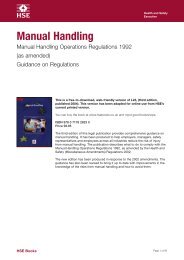Making Companies Safe - what works? (CCA ... - Unite the Union
Making Companies Safe - what works? (CCA ... - Unite the Union
Making Companies Safe - what works? (CCA ... - Unite the Union
Create successful ePaper yourself
Turn your PDF publications into a flip-book with our unique Google optimized e-Paper software.
The evidence reviewed in part two shows that formal enforcement strategies work, but that<br />
current levels of inspections, investigations and prosecutions in <strong>the</strong> UK do not maximise <strong>the</strong>ir<br />
potential, and that <strong>the</strong> HSC should expand this part of its activities.<br />
However that is not <strong>the</strong> approach that <strong>the</strong> HSC/E is taking – or indeed <strong>the</strong> approach <strong>the</strong><br />
Government wants <strong>the</strong>m to take. Instead, it appears to be going down a route which will<br />
involve less enforcement by requiring inspectors to provide information in contexts where<br />
<strong>the</strong>re is no threat of inspectors issuing notices or/and pursuing prosecutions.<br />
Since <strong>the</strong> evidence suggests that formal enforcement is a successful tool to secure employers’<br />
compliance and has a positive impact of health and safety outcomes, this does not seem to<br />
be a rational response to <strong>the</strong> evidence. However, it is possible that whilst formal enforcement<br />
<strong>works</strong>, seeking compliance ‘voluntarily’ may be as, or more, effective.<br />
As stated earlier, <strong>the</strong> HSC has always spent some of its time engaged in strategies to secure<br />
compliance voluntarily, so this part of <strong>the</strong> report looks at how effective <strong>the</strong>se strategies have<br />
proven to be and whe<strong>the</strong>r, despite <strong>the</strong> evidence that formal enforcement <strong>works</strong>, <strong>the</strong> HSC can<br />
still credibly argue that its new approach is evidence-based.<br />
Part Three comprises of three chapters:<br />
• Chapter seven is an assessment of <strong>the</strong> evidence on <strong>the</strong> effectiveness of education and<br />
information provision activities. As is explained, <strong>the</strong> effectiveness of this strategy<br />
depends on <strong>the</strong>re being a positive relationship between employer awareness of <strong>what</strong> to<br />
do and employers actually doing it.<br />
• Chapter eight is a short chapter that considers <strong>the</strong> effectiveness of developing strategic<br />
partnerships and relationships with key organisations.<br />
• Chapter nine looks at whe<strong>the</strong>r <strong>the</strong>re is evidence that employers find arguments that<br />
<strong>the</strong>ir profits and reputation will be harmed unless <strong>the</strong>y comply with health and safety<br />
law persuasive, and if so whe<strong>the</strong>r this acts as an incentive for <strong>the</strong>m to improve <strong>the</strong>ir<br />
occupational health and safety performance.<br />
• Chapter ten is an assessment of a new proposal that certain employers might be<br />
granted ‘autonomy’ from routine preventative inspections.<br />
57
















